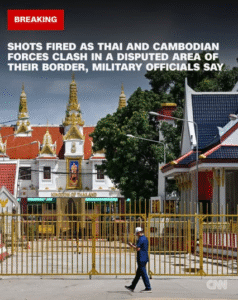Thai fighter jets launched a series of precision airstrikes on Cambodian military targets amid a sharp escalation of a long-standing border dispute between the two Southeast Asian nations. The strikes, which occurred early Thursday morning, reportedly targeted Cambodian artillery positions, troop encampments, and radar installations near the contested Preah Vihear region. The move marks a significant intensification in hostilities, with the use of airpower suggesting a dangerous shift from localized skirmishes to large-scale military confrontation.
According to a statement from the Royal Thai Armed Forces, the operation was in response to what it described as repeated violations of Thai airspace and aggressive maneuvers by Cambodian forces within a disputed border zone. Military officials claimed the strikes were designed to “neutralize immediate threats” and “safeguard Thai territorial integrity.” The Thai government emphasized that it had exhausted diplomatic avenues before taking military action.
Cambodia, in turn, has condemned the airstrikes as a blatant act of aggression. Prime Minister Hun Manet addressed the nation, calling the bombing campaign an “unprovoked and unjustified assault” on Cambodian sovereignty. He announced a nationwide military alert and ordered reinforcements to the northern border. Cambodian military sources confirmed casualties and infrastructure damage but did not specify the number of injured or dead.
Eyewitnesses in Cambodian border towns described loud explosions, smoke rising from hilltop installations, and panicked civilians fleeing the area. Several villages near the blast zones have reportedly been evacuated, with thousands seeking shelter farther from the conflict zone. Humanitarian agencies are mobilizing in anticipation of a refugee surge if fighting continues.
This latest escalation centers around the disputed land surrounding the ancient Preah Vihear temple, a UNESCO World Heritage site awarded to Cambodia by the International Court of Justice in 1962. Despite that ruling, control over surrounding territory has remained contentious, leading to periodic clashes, most notably in 2008 and 2011. However, this marks the first use of sustained aerial bombardment in the conflict’s history.
Military analysts warn that Thailand’s deployment of fighter jets signals a calculated strategy to establish air dominance and dissuade Cambodian ground advances. Images shared on social media and confirmed by satellite data show craters and destroyed structures consistent with air-dropped ordnance. Cambodia’s air defenses, while limited, have been activated in response, and the government claims to have downed at least one Thai drone.
International reactions have been swift and urgent. The United Nations has called for an immediate ceasefire and warned of a potential humanitarian crisis if tensions are not defused. ASEAN, the regional bloc to which both Thailand and Cambodia belong, is facing pressure to intervene diplomatically. An emergency summit is reportedly being organized to mediate between the two parties.
Neighboring countries, including Vietnam and Laos, have expressed concern over the rising violence and urged both sides to engage in dialogue. The United States, China, and the European Union have also called for restraint and have offered to mediate peace talks.
Inside Thailand, public reaction is mixed. While some support the government’s firm stance on defending national borders, others fear the consequences of a prolonged conflict. Anti-war protests have been reported in Bangkok and Chiang Mai, with demonstrators urging the government to pursue peaceful resolution. Cambodian citizens, meanwhile, have rallied in support of their troops, with many donating supplies and calling for international justice.
The Thai parliament has convened an emergency session to assess the situation, and military forces across the northern provinces remain on high alert. Cambodia has begun mobilizing its reserve forces and repositioning missile systems and artillery to prepare for potential retaliatory strikes.
Despite the rhetoric from both governments, backchannel diplomacy is reportedly underway. ASEAN officials are in contact with both sides, and some foreign embassies have begun evacuating non-essential personnel from areas near the conflict zone.
The situation on the ground remains tense and unpredictable. Both countries have a history of nationalistic fervor tied to the border region, and analysts warn that even a minor miscalculation could trigger a broader regional conflict. The next few days will be critical as international pressure mounts for a ceasefire and peaceful negotiation.
As the world watches, civilians on both sides of the border face the reality of an uncertain future, caught in the crossfire of political and military posturing. The need for swift diplomacy has never been greater, as the risk of all-out war looms over Thailand and Cambodia.


